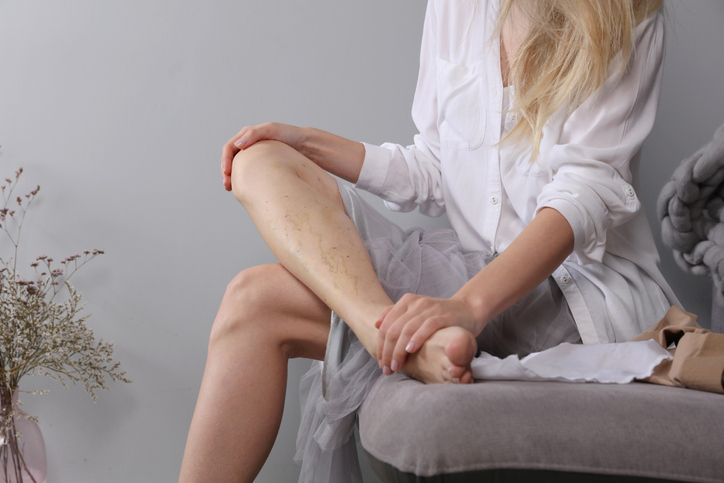Leg swelling can be scary and anxiety-provoking when its new, then annoying and uncomfortable when its been going on for a while.

There is a variety of causes for swollen legs, but luckily there are also several things that can be done to find the cause and treat it. Here is what to do for swollen legs:
Defining Mild, Moderate and Severe Leg Swelling
Characterizing the degree of swelling, also called edema, is an important first step. It is common for patients to find that their swollen leg worsens as the days goes on, especially when the swelling is due to venous causes.
Mild leg swelling is limited to the foot and ankle area. For example, a little puffiness at the end of the day.
Moderate leg swelling extends above the ankle but below the knee.
Severe leg swelling extends from the foot and ankle to the knee and above. In some cases, the swelling can be so severe the skin cracks open and becomes infected or wounds develop that leak fluid.
Along with the severity of the swelling, practitioners also look to define if the edema is pitting or non-pitting. Pitting edema respond to pressure, usually from a hand or finger. When you press on the skin with your finger, pitting edema will leave an indentation, even after you remove your finger. Non-pitting does not. This can help practitioners understand possible reasons for the swollen leg.
Evaluation of the Swollen Leg
When evaluating leg swelling, two questions are important:
1. Is the swelling new or has this been going on for a while?
Acute…or new swelling, makes one concerned if there might be some form of obstruction. The most common reason for vein obstruction is deep venous thrombosis. At times there can be compression of the veins in the pelvis, known as the May Thurner Syndrome (MTS).
All this can be evaluated quite rapidly by a vein specialist, who will obtain a venous ultrasound to evaluate the veins in the legs and, sometimes, pelvis. Sometimes the leg is so swollen in the calf the veins cannot be seen. Most programs have a protocol for this problem that usually involves ruling out a clot higher in the leg and then working on the swelling and brining the patient back to rescan with ultrasound after a few days.
In addition to acute swelling, chronic leg swelling is also important to evaluate. Chronic swollen legs are less likely to be related to a new blood clot and more likely to be due to some combination of chronic venous insufficiency and lymphedema. These two can go hand in hand….the so called “phlebolymphedema.”
2. Is it the swelling on one leg or both legs?
Swelling in both legs, especially with pitting, can at times be due to medical problems such as heart failure, liver or kidney failure or other medical problems. So it’s important for the care providers to look at the whole picture when evaluating swollen legs and work with the primary care team for more comprehensive work up when indicated.
Initial Treatment of the Severely Swollen Leg
First, it’s important to compress the leg. This can squeeze the tissue and help mobilize the fluid back to the deeper veins where it can be eliminated from the legs. Think of it like squeezing a wet sponge to get the fluid out.
This is most commonly done with compression stockings. Compression, even in just a few days, can make a big difference in many patients.
Some people, however, are so swollen they cannot get compression stockings on. Or some patients simply cannot put on a compression sock due to back and other physical problems. In this case, the vein providers can start off with a program to wrap the legs with multi-layer inelastic compression. These can be changed out at the vein clinic after 3 or 4 days while the swelling is initially treated. This process is repeated a few times.
At some point, one can make the conversion from wrapping to a graded compression sock or other form of compression, such as the Circaid Velcro wrap.
The goal, however, is to get a person to a compression sock they can put on at home. This can take a few weeks of closely working together, however. If wounds are present, an Unna Boot can be applied until the skin heals.
Compression will speed the time to wound closure by reducing the leg swelling. Physical therapy sessions for manual lymphatic drainage and de congestive therapy can also help in some cases. For patients with a lot of swelling, it may be necessary to use an “all of the above” multi-modality approach to get the swelling under control and decrease symptoms such as ache, pain and skin problems.
Its important to understand the patient will have to compress the swollen leg over the long term. So figuring out how to use compression stockings is important, even if it takes a few months.
Treating Swollen Legs Due to Chronic Venous Insufficiency
A major contributor to leg swelling in many patients is venous insufficiency. This leads to blood pooling in the lower legs and then fluid weeping into the tissues. If you can treat the venous insufficiency, the load of fluid in the legs contributing to the swollen leg will go down. For many patients this makes a big difference.
There are a variety of treatments available at the Inovia Vein Specialty Centers including Closurefast RFA, VenaSeal and Varithena. All are FDA approved and there is considerable clinical evidence published in the medical literature supporting their use in the right patients.
If you are interested in learning more about varicose veins treatment options, simply fill out our Online Appointment Request Form or call any of our clinics in Northwest Portland , Tigard, Happy Valley, Hillsboro or Bend, Oregon.